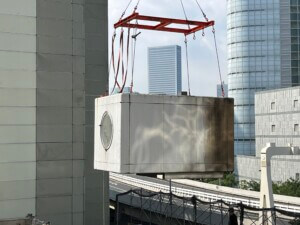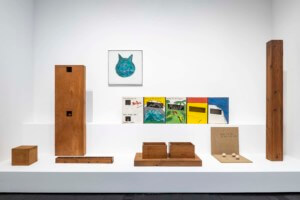Jennifer Dunlop Fletcher was recently named the head of the department of architecture and design at the San Francisco Museum of Modern Art (SFMOMA), filling a position vacated by Henry Urbach more than two years ago. Fletcher just completed a assessment of the museum’s architecture and design collection, and, most recently, she co-curated the exhibition Lebbeus Woods, Architect. She sat down with AN editors Nicole Anderson and Alan G. Brake to discuss her plans for the department.
The Architect’s Newspaper: What direction do you plan to take the architecture and design department?
Jennifer Dunlop Fletcher: The collection just turned 25 and so I think it was important that my colleague Joseph Becker and I, along with Henry Urbach, really undertook a collection analysis and are trying to draw on the identity and strengths of the collection: the experimental and conceptual architecture, the iconic chairs that capture every 20th century design movement, and then the Bay Area collection.
We’ll definitely continue with focusing in those areas, and in this interim period, spend some time drilling down on some connections between the two like Bay Area experimental architecture like Ant Farm and some of the architects coming out of California. Thanks to Aaron Betsky we happen to have some great early drawings by Morphosis and Thom Mayne, and Neil Denari and want to revisit those moments. We’ve definitely been in dialogue with those guys. Also through this Lebbeus Woods show, kind of looking back at that moment around the founding of the Storefront for Art and Architecture. That seems a little under collected and something that because of the architecture department coming around in the late 80s, it is what Aaron and a lot of people were very interested in.
We want to explore product design, but produce design where it merges with technology because of our obviously being embedded right there in the Bay Area. And it is infiltrating every field. You see it even in the graphic design and the architecture, with responsive buildings. I think just what we want to do with product design is not just collect it, but probably take the time working with our conservation department and interpretation department to figure out how to not just maintain it and upgrade it, but how to display it. Because all of a sudden, the moment of just displaying the hardware, the iPhone just as hardware, has passed.
Any specific ideas about how you will display the product design?
We haven’t landed on any clear avenue to take yet because we also recognize within product design there is the extra challenge of how to deal with a commercial product. Film or these kinds of media that we’re used to, marketing departments already use. And it is very expensive to invest in yet another film. Maybe in 20 years from now, the marketing itself will be kind of interesting.
It is a challenging question given the rate that technology is developing and changing. How do you evaluate what is going be influential?
It seems that we as even as museum professionals and media are so quick to identify something that could potentially be a game changer. I feel like at the museum we really need to take the time to say why is this culturally relevant? And interpret it in that context.
There is also a side of me that says the museum—this holder of objects—and maybe we’re already moving towards no objects. Maybe we should not even be trying to go in that direction. If we are beholden to our 5000 objects that we already have—we may land on this might not be appropriate for us to pursue because we have this building and this collection and it would be abandoning this past. I don’t know, but this is what is exciting to me—what lies ahead.
And in the meantime while the building the expansion is being completed, are you working on any with other cultural organizations collaborations outside of the museum?
We are part of this project in Los Altos in the middle of Silicon Valley. It is the neighbor city to Palo Alto. It is also one of the wealthiest cities, wealthier than Beverly Hills. Downtown has State and Main Streets—so it’s a classic American city and there are a number of empty storefronts, so the city invited the museum to occupy temporarily these storefronts in order to show some works of art that dealt with the context of Silicon Valley. I am already working with Mike Mills, the filmmaker and graphic designer. He has done a couple of videos and films on suburbia and identity. He has proposed a piece that deals with the past but starting in 1976, the moment when the first Apple computer was built in a garage there in Los Altos, to the present and then the future. He has proposed interviewing children of employees of some of the tech companies and asking them about the future—what would you design for the future? It is a little revisiting Buckminster Fuller when he invited children to ask him about the world and the future.
Is there anything you’re particularly excited about in terms of using the new building?
We have a set architecture and design gallery which we have always had in the existing building, but also we will have more opportunities to use the larger temporary exhibition space on the 4th floor to do larger exhibitions that would travel. And be more collegial with peer institutions. Really get the SFMOMA collection in conversation with other collections and share the scholarship. Also at the same time, accept exhibitions.
We have affinities with the FRAC and the Pompidou with the experimental architecture and our interest in product design relates to MoMA. Look at LACMA and their California emphasis and our Northern California emphasis.
I am not really ready to talk about this other proposal we have in the city—because we really want to do something that is not in the gallery at all but in the city.
In your analysis of the collection, were there any happy discoveries that you weren’t aware of or things that struck you in a new way?
I think looking at the kind of beginning why every curator has continued this strand of conceptual architecture and where Paolo Polledri was the first A&D curator—really looking locally and inviting architects to address the Bay area. Aaron Betsky was sort of voraciously looking outside the Bay area and seeing this moment in Los Angeles and in New York happen. So looking at that strand of where I think Paolo called it visionary and Aaron was calling it conceptual and Joe Rosa was calling it un-built works.
Can you comment on at all where you see the architecture scene in the Bay Area today? There seems to be a lot of built work happening.
There is a lot of built work happening. There is a lot of repurposing happening. We are going to be right next to the new Yelp headquarters, which is in the Timothy Pflueger building from 1927. Particularly in the Bay Area because a lot of the practitioners have access to tech companies and robotics that responsive architecture is emerging here—which we are so well positioned to look at with our interest in technology—architecture that is not just fabricated in a new method but responds to occupancy and climate. And also recognizing that these were early hopes from architects of the 1960s. This kind of Ant Farm movement, but ok now we know what technology can do.
Is there anything else you would like to comment on?
I don’t want to ignore our iconic chair collection. Along with our look at how to display product design. I think we’re also thinking will this trickle down into the pre-software products. We have all recognized that when you put a chair on display in a museum, you’re taking away its function. But maybe what we learn from how to display software maybe that would inform how we might display a chair.










